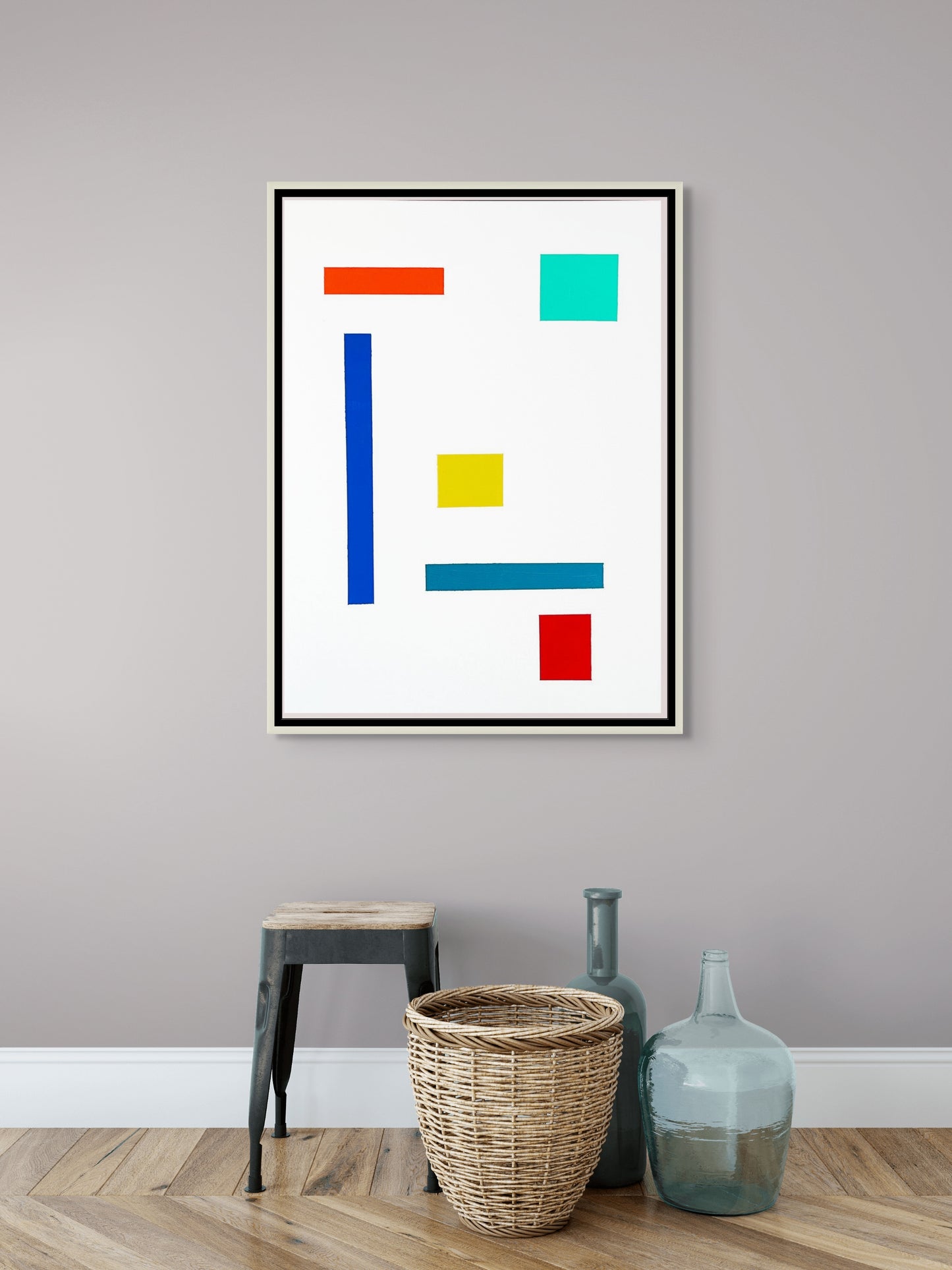Yellow Square, 30" x 40"
Yellow Square, 30" x 40"
See more paintings from the Floating Color Collection.

James Nowak’s Yellow Square, from his Floating Color Collection, offers a meditation on balance, clarity, and resonance through geometric abstraction. Unlike figurative art, which narrates through imagery, this work communicates through the interplay of color, form, and space. The yellow square, as the title indicates, is the painting’s focal element—not dominant through size but commanding through luminosity and symbolic weight.
The composition is sparse yet highly intentional. A vertical blue bar on the left and a horizontal teal bar below establish structural stability, recalling architectural scaffolding or a minimalist grid. Above, a red horizontal bar energizes the space, while a cyan square to the right adds expansiveness and counterbalance.
The yellow square rests at the center, not geometrically exact but optically central, serving as the pivot for the composition. At the bottom right, a smaller red square grounds the field, injecting visual rhythm and echoing the upper red bar.
What emerges is a dialogue of horizontals, verticals, and squares, arranged in asymmetrical harmony. The white background provides openness, transforming the canvas into a space where forms float in suspension rather than settle into rigid structure.
The yellow square is modest in scale but central in significance. Its placement within the network of bars and squares allows it to function as a radiant core—an emblem of light, clarity, and energy. Unlike the black squares in The Green Square or Sunshine, which introduce gravity and shadow, the yellow square embodies optimism and vibrancy.
By situating it amid strong structural forms, Nowak elevates the square beyond decoration, making it both anchor and illumination.
Nowak’s palette in Yellow Square is concise yet striking:
- Yellow radiates brightness, functioning as the visual and emotional center.
- Blue (dark and cyan) provides both grounding and lift, suggesting stability and openness.
- Red injects dynamism and contrast, positioned in dialogue between top and bottom.
- Teal cools and stabilizes, serving as a transitional hue between the warmer and cooler tones.
The colors are flat, unmodulated, and pure, reinforcing the geometric clarity. The result is not chaos but a carefully tuned composition in which each color carries both formal and symbolic weight.
In line with the Floating Color Collection, the painting achieves buoyancy. The shapes hover in the white void, untethered to gravity or perspective. Yet the vertical and horizontal alignments provide enough scaffolding to prevent dissolution into randomness.
This creates a paradoxical effect: the work is simultaneously floating and grounded, improvisational and structured. The yellow square becomes a beacon within this suspended field, a point of reference amid drifting forms.
Yellow Square resonates with optimism, clarity, and gratitude. The yellow center feels like a burst of sunlight, offering warmth and focus in an otherwise open and sparse composition. The presence of red and blue adds emotional complexity—passion and stability—while teal and cyan soften the contrasts, evoking serenity.
Thematically, the painting can be read as a meditation on how clarity (the yellow square) emerges within structures of order and tension. It suggests that brightness is not isolated but interdependent with other forces—discipline, vitality, and openness.
Nowak’s work engages with the lineage of geometric abstraction, particularly the legacy of Piet Mondrian and the De Stijl movement. Yet unlike Mondrian’s rigid grids, Yellow Square allows for openness and asymmetry, embracing floating imbalance as part of its rhythm. The piece also recalls the color purity of Ellsworth Kelly and the spiritual simplicity of Kazimir Malevich, while diverging from both in its playful suspension of forms.
By balancing rigor with buoyancy, Nowak reclaims geometry as a living, emotional language rather than a purely formal one.
James Nowak’s Yellow Square exemplifies the philosophy of the Floating Color Collection: abstraction as a meditation on balance, freedom, and resonance. Through its modest but luminous central square, the painting captures the paradox of clarity—how brightness emerges within a field of tension, how harmony arises from imbalance. At once rigorous and buoyant, Yellow Square transcends simple geometry to embody both visual delight and philosophical reflection.

